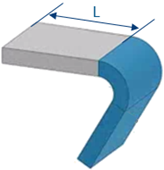Creating a Flange | ||||||
|
| |||||
-
From the
Detail section of the
action bar,
click
Flange
 .
The Flange dialog box appears.
.
The Flange dialog box appears. -
In the
Plate box, select a plate
on which the flange is to be defined.
Important: You cannot select a panel. The edges on which a flange can be created are highlighted. -
In the
Edge box, select one or more highlighted
edges.
Tip: You can also extract edges using the Create Extract contextual command and select them. Important: The edge must be straight, and must belong to the boundary element of the plate. - In the Mode list, select Centered or Tangent.
-
In the
Flange Width box, enter a value (say
300mm).
You can use one of the following options to select a reference for width calculation:
Option Reference 
Inner face 
Outer face -
In the
Angle box, enter the required bending angle
value (say
60 degree).
This value indicates the angle by which flange will bend from the plate.
Note: Click Flip to change the flange orientation. -
In the
Radius box, specify radius between the plate
and the flange.
In Structure Functional Design, the radius is not visible in the representation.
- Optional:
To create a flange without increasing the overall length of the plate, select
one of the following Trim options:
The above table shows the representations of the physical objects created after synchronization.Without Trim Inner Trim 
Outer Trim 



Where, L is length of the plate. - Optional:
Under the
Limits area, select the start and end limits.
You can select reference planes or surfaces to limit the flange. You can also define the offset value for the start and end extremity.
- Optional:
Under the
End Cut area:
-
In the
Distance box, enter the distance from the
free edge, to position the end cut.
Important: The distance should not be greater than flange width. -
In the
Angle box, enter the required value.
The angle is always counted from the vertical edge of the flange.
- In the Radius box, enter the end cut radius.
You can set the same end cut parameters for start and end extremities, by keeping the chain mode active.
-
In the
Distance box, enter the distance from the
free edge, to position the end cut.
-
Click
OK.
The flange is created. In the tree, the flange is aggregated under the plate.